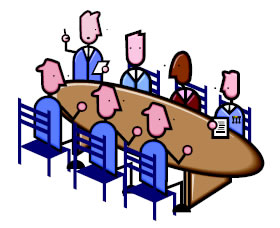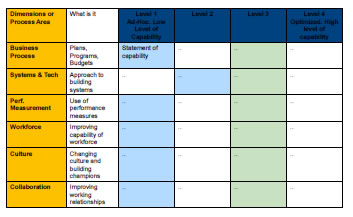Utilizing the Work Zone Capability Maturity Framework to Improve Work Zone Management Capabilities and Process Review Efforts
Printable version [PDF 528 KB]
You may need the Adobe® Reader® to view the PDFs on this page.
Contact Information: Operations Feedback at OperationsFeedback@dot.gov
slide 1
Utilizing the Work Zone Capability Maturity Framework to Improve Work Zone Management Capabilities and Process Review Efforts

FHWA Work Zone Management Program
slide 2
Webinar Presenters
- Jawad Paracha – FHWA Office of Operations
- Work Zone Management Program Manger
- Jerry Ullman – Texas A&M Transportation Institute
- Senior Research Engineer, Work Zone and Dynamic Signs
- Bill Oldenburg – New Hampshire Department of Transportation
- Assistant Director of Project Development
slide 3
Webinar Agenda
- Work Zone Capability Maturity Framework (WZ CMF) Background and Overview
- Using the WZ CMF to Improve Process Reviews
- New Hampshire DOT Experience with WZ CMF
- Work Zone CMF Workshop Deployment and Trends
- Future Opportunities and Resources
slide 4
Work Zone Capability Maturity Framework Concept and Process
slide 5
Capability Maturity Frameworks

slide 6
CMF Products
- Agency or regional findings related to capability
- Capability assessment by dimension
- Suggested actions for improvement

Consensus-based Assessment

Current Capability

Prioritized Actions for Improvement
slide 7
CMF Outcomes
- Jumpstarts the improvement process
- Focus is on immediate weaknesses
- Helps prioritize key organizational changes that can have major impact
- Provide justification for actions
- Actions are based on sound rationale and a consistent assessment of capability
- Improve consistency and collaboration
slide 8
Program Area Frameworks
- Traffic Incident Management
- Planned Special Events
- Work Zone Management
- Road Weather Management
- Traffic Signal Management
- Traffic Management
- More focused actions
- Bottom-up improvement in capability
- Engagement of program-specific stakeholders
https://ops.fhwa.dot.gov/tsmoframeworktool/available_frameworks/
slide 9
Work Zone Management CMF
- Assesses the institutional capacity of an agency or a region to effectively manage the safety and mobility impacts that result from work zones
- Involves agency personnel from multiple divisions, field offices, and other stakeholders (law enforcement, contractors, other public-sector agencies, etc.)
- Goal is to identify a set of prioritized actions for improvement that address institutional barriers for effective work zone management
slide 10
WZM Dimensions

slide 11
Levels of WZM Capabilities

slide 12
Online Tool
slide 13
Incorporating the Work Zone Capability Maturity Framework into Process Reviews
slide 14

slide 15
Using the WZ CMF to Initiate a Process Review
- Conduct a WZ CMF to assess current capabilities and identify any uncertainties about capabilities
- Identify information/data that are needed to improve understanding of capabilities
- Use process review to gather needed information and data
- Use WZ CMF action item list to tailor process review recommendations and roadmap for future process reviews
slide 16
Using the WZ CMF as a Process Review is Being Completed
- Use the WZ CMF to verify whether the focus areas of the current process review targeted the dimensions/areas with improvement needs
- Align selected actions from WZ CMF with conclusions and next steps of process review
- Establish roadmap and goals for next process review(s)
slide 17
New Hampshire Department of Transportation Experience
Bill Oldenburg – Assistant Director of Project Development
slide 18
NHDOT Experience
- Workshop Motivation
- Offer an objective outside view of our procedures.
- Allow us to review our procedures against the requirements.
- Allow us to development opportunities for improvement.
- Allow us to prioritize our future bi-annual Process Reviews.
- Workshop Outcomes
- Update our Procedures
- Develop Guidance on which Projects are Reviewed
- Develop Designer Guidance Documents
slide 19
NHDOT Experience
| Business Processes |
| 1 |
Revisit,review, and update significance exemption list. |
| 2 |
Update checklist of projects that must be brought before Work Zone Traffic Control Committee for a determination of significance. |
| 3 |
Review traffic control plan review processes currently in place in other agency units, such as Districts, Utilities, and LPAs. |
| 4 |
Develop guidance on developing presentations for Work Zone Traffic Control Committee significance determination meetings. |
| Organization and Workforce |
| 5 |
Develop guidance for designers on reasonable accommodation for pedestrians in work zones. |
| 6 |
Utilize the Work Zone Traffic Control Committee to inform designers on newly available pedestrian accommodation guidance. |
| 7 |
Review available work zone management training resources on Work Zone Safety Information Clearinghouse and utilize these materials to develop a comprehensive work zone management training module to set expectations for staff on work zone management requirements. |
| Performance Measurement |
| 8 |
Evaluate at which stage in the Project Development process each project is coming before the Work Zone Traffic Control Committee. |
| 9 |
Improve the percentage of projects that are coming before Work Zone Traffic Control Committee sufficiently early in the Project Development process. |
| 10 |
Investigate newly available work zone crash data to identify work zone crash trends. |
| 11 |
Utilize new crash data and work zone crash data trends to develop work zone safety performance metrics and set performance goals. |
| Collaboration |
| 12 |
Finalize work zone speed limit determination flow chart in collaboration with Association of General Contractors. |
slide 20
NHDOT 2018 Process Review
- Update Work Zone Mobility Policy (Policy)
- Update Work Zone Safety and Mobility Policy and Implementation Guidelines. (Manual)
slide 21
NHDOT 2018 Process Review
- Revisit, review, and update significance exemption list (Item #1),
- Update checklist of projects that must be brought before Work Zone Traffic Control Committee for a determination of significance. (Continued effort from our 2016 Self–Assessment)(Item #2),
- Review traffic control plan review processes currently in place in other agency units, such as Districts, Utilities, and LPAs. (Item #3),
- Develop guidance on developing presentations for Work Zone Traffic Control Committee significance determination meetings.
(Item #4),
- Develop guidance for designers on reasonable accommodation for pedestrians in work zones. (Continued effort from our 2016 Self–Assessment)(Item #5),
slide 22
NHDOT Experience
2018 Process Review
✓ Business Processes
✓ Organization and Workforce
✓ Collaboration
2020 Process Review:
✓ Performance Measurement
slide 23
NHDOT Contact
Bill Oldenburg
Assistant Director of Project Development
New Hampshire Department of Transportation
William.Oldenburg@dot.nh.gov
(603) 271-1486
slide 24
Work Zone Capability Maturity Framework Workshop Deployment
slide 25
Workshops Conducted to Date
Missouri Department of Transportation
Florida Department of Transportation
Colorado Department of Transportation
Virginia Department of Transportation
Kansas Department of Transportation
Pennsylvania Turnpike Commission
Tennessee Department of Transportation
Kentucky Transportation Cabinet
Washington State Department of Transportation
Arkansas Department of Transportation
Montana Department of Transportation
Arizona Department of Transportation
Iowa Department of Transportation
California Department of Transportation
Delaware Department of Transportation
New Mexico Department of Transportation
Vermont Agency of Transportation
Oklahoma Department of Transportation
Minnesota Department of Transportation
New Hampshire Department of Transportation
South Carolina Department of Transportation
slide 26
Average CMF Scores

slide 27
Lowest Rated Questions
- Performance Measurement
- How well does your agency quantify WZM performance?
-
How are WZM performance measures used by your agency?
- Culture
- What type of agency WZM outreach and reporting exists?
slide 28
Lowest Rated Questions (Continued)
- Organization and Workforce
- How well are WZM knowledge, skills, and abilities developed amongst staff within the agency?
- How well is institutionalized WZM knowledge in various parts of the agency captured and shared?
- Systems and Technology
- How well does your agency assess and adopt new technology, procedures, and strategies to help meet WZM needs?
slide 29
Highest Rated Questions
- Collaboration
- How does the agency utilize law enforcement for WZM needs?
- How does the agency consider private-sector input (e.g., contractors, affected businesses) when addressing WZM needs?
- How does the agency incorporate other stakeholders (general public, schools, business, emergency medical services, etc.) into the WZM process?
slide 30
Highest Rated Questions
- Culture
- How is WZM innovation encouraged within the agency?
- Business Processes
- How well does your agency develop, implement, and evaluate transportation management plans (TMPs)?
- Systems and Technology
- How does your agency apply existing technology already in place to address WZM needs?
slide 31
Commonly Selected Action Items
- Performance Measurement
- Identify outcome measures relative to mobility, safety, customer satisfaction, and/or work productivity/efficiency that are specified or implied in agency's work zone safety and mobility policy.
- Identify available data sources and data collection methods needed to develop measures of interest to the agency.
- Determine number of projects to include in assessment and select projects for which measures will be computed.
- Culture
- Create a WZM steering committee of key agency champions and WZM core staff.
slide 32
Commonly Selected Action Items (Continued)
- Organization and Workforce
- Assemble basic WZM training and capability-building activities available within agency and region.
- Identify organizational units within agency where critical WZM knowledge and skills are required.
- Develop a formal and ongoing training program on WZM that is offered and supported by the agency.
- Develop a process for collecting and synthesizing de-briefing notes from major projects at a central location and share key lessons learned with staff in appropriate units.
- Regularly assess compiled lessons learned and determine which should be incorporated as best practices into agency standards, manuals, guidance, etc.
slide 33
Contact Information
If you are interested in learning more about the WZ CMF, improving process review efforts using the WZ CMF, or hosting a WZ CMF + Process Review workshop:
Jawad Paracha
FHWA Office of Operations
Work Zone Management Program
Jawad.Paracha@dot.gov
slide 34
Thank You!
Questions?







